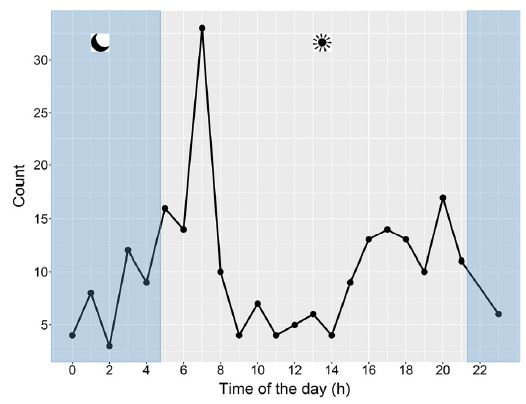Environmental change through anthropogenic influences
Anthropogenic influences as triggers of changed behavior or species endangerment
According to IUCN (2021), IPBES (2021) and WWF (2020) reports, the so-called Anthropocene, as the current era in which human-induced changes in the Earth's geology are occurring, is characterized by significant biodiversity losses. According to IPBES (2021), ocean and land areas are affected, with 87% and 77% change (excluding Antarctica) respectively currently assumed. Animals are also affected by many stressors, some of which are new to them. Therefore, current research on human-animal interactions1, influences on species-specific feeding ecology2, and climate change projections3 are of particular relevance.
The interaction behavior of Scopoli´s shearwaters (Calonectris diomedea) was studied with regard to interaction with fishing vessels, as these were tapped by the birds as a new food source (fish discard)1. However, this use proved to be problematic because, on the one hand, the birds competed with the intensively operated fishery for their classic food resource and, on the other hand, the fish discard alternatively used by them had lower nutrient values than the natural food1. Only 40% of the Sepia shearwaters used the new food source (Fig. 1), preferably in the morning1. These individuals had both longer flight times and longer flight distances for their other foraging trips1. It is reasonable to conclude that fishing-induced overexploitation results in competitive exclusion of low-competition birds near the breeding colony1. Disadvantaged individuals are forced to evade by the pressure of their stronger conspecifics1. They must therefore use fish discard to cover the higher energy costs of reaching more distant foraging areas1. European Union plans to ban discarding of fish discard should therefore first be implemented gradually and with monitoring of the local Scopoli´s shearwater population1.

Fig. 1: Number of interactions between birds and fishing vessels calculated per time of the day (GMT +2). The grey area indicates the night hours1
Mercury concentrations in surface water have tripled compared to the pre-Anthropocene period due to human activities (e. g. fossil fuel use)2. The trace element (Hg) can cause strong negative effects on body functions (nervous, reproductive, and immune systems) even at low concentrations2. Through marine food webs, biomagnification has a particularly strong effect on long-lived top predators such as seabirds2. Concentrations can be detected in blood, muscle, and feathers2. In the present study, stable δ13C and δ15N isotopes were examined in seven sympatric breeding procellariformes species from the Chatham Islands (New Zealand)2. While δ13C values provide information on latitude of foraging areas, δ15N values represent trophic position2. Species affiliation (gadfly petrels) and foraging habitats (oceanic zone) were identified as the main drivers of Hg concentrations2. The critically endangered Magenta Petrels (Pterodroma magentae) as well as the Chatham Petrels (Pterodroma axillaris), considered endangered, had the highest Hg levels in blood and feathers2. P. magentae, with the highest blood and feather contamination, thus showed 35-fold values in feathers compared to the least contaminated species, Gray-backed Petrels (Garrodia nereis) 2. Further information on mercury concentrations could be obtained from future studies of other Pterodoma species2.
One of the few studies that addressed possible microclimatic changes in the host-parasite relationship due to climate change was conducted by experimentally increasing nest cavity temperatures in blue tit (Cyanistes caeruleus) nests in Spain and Germany3. The goal was to enable more accurate predictions of future global trends through better understanding3. The different climates of the both study sites were reflected by differing parasite faunas3. While in Spain blowfly species (Protocalliphora azurea) and biting midges (genus Culicoides) as well as blood parasites were more prevalent, in Germany higher flea abundances (Ceratophyllus gallinae) were found. Moderate use of heating mats increased the average nocturnal mean temperature of nest boxes by 2.34 °C (Spain) and 1.35 °C (Germany) during the breeding period, which decreased the average relative humidity by 4.93 (Spain) and 0.82 units (Germany)3. As a result, a decreased abundance of blowfly pupae in temperature-manipulated nest boxes was detected at both study sites, while a decreased abundance of flea larvae was determined exclusively for Spain3. Regarding blood parasite infection (Haemoproteus/Plasmodium), lower numbers of infected erythrocytes were found for males of unheated control nests (Fig. 2) in the south (Spain) and of heated nests in the north (Germany)3. A negative relationship of both male body mass and nestling wing length to flea larval abundance was present, so positive fitness effects in blue tits due to altered parasite prevalence were evident from the experiment3. However, stronger or daily longer lasting temperature increases would potentially result in negative effects on the prevalence of some parasites but also in negative effects on the development of nestlings3.

Fig. 2: Differences in the abundance of Haemoproteus/Plasmodium in blue tit males by treatment and locality. Means ± intervals of confidence at 95% are shown3 (Fig. 3 p. 293).
References
1. Cianchetti-Benedetti M, Dell’Omo G, Russo T, Catoni C, Quillfeldt P (2018): Interactions between commercial fishing vessels and a pelagic seabird in the southern Mediterranean Sea. BMC ecology, 18(1), 54. https://bmcecol.biomedcentral.com/articles/10.1186/s12898-018-0212-x
2. Thébault J, Bustamante P, Massaro M, Taylor G, Quillfeldt P (2021): Influence of species-specific feeding ecology on mercury concentrations in seabirds breeding on the Chatham Islands, New Zealand. Environmental Toxicology and Chemistry 40: 454-472.
https://setac.onlinelibrary.wiley.com/doi/pdfdirect/10.1002/etc.4933
3. Castaño-Vázquez F, Schumm YR, Bentele A, Quillfeldt P, Merino S (2021): Experimental manipulation of cavity temperature produces differential effects on parasite abundances in blue tit nests at two different latitudes. International Journal for Parasitology: Parasites and Wildlife, 14: 287-297. In Press. https://www.sciencedirect.com/science/article/pii/S2213224421000420
